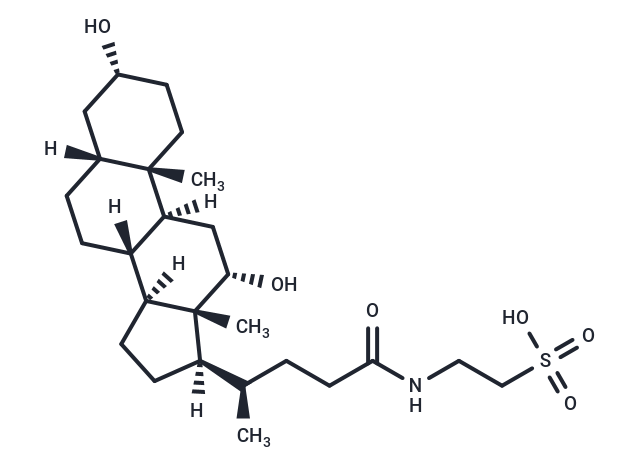Shopping Cart
Remove All Your shopping cart is currently empty
Your shopping cart is currently empty
Taurodeoxycholic acid (Taurodeoxychloic acid) is a bile acid taurine conjugate of deoxycholic acid, a human metabolite that stabilizes mitochondrial membranes and reduces the formation of free radicals.Taurodeoxycholic acid inhibits apoptosis by blocking calcium-mediated apoptotic pathways and by activation of caspase-12. Taurodeoxycholic acid has neuroprotective activity and has been used to study 3-nitropropionic acid-induced or stabilized hereditary Huntington's chorea (HD).

| Pack Size | Price | USA Warehouse | Global Warehouse | Quantity |
|---|---|---|---|---|
| 1 mg | $48 | In Stock | In Stock | |
| 5 mg | $112 | In Stock | In Stock | |
| 10 mg | $162 | In Stock | In Stock | |
| 25 mg | $273 | In Stock | In Stock | |
| 50 mg | $442 | In Stock | In Stock | |
| 100 mg | $648 | In Stock | In Stock | |
| 1 mL x 10 mM (in DMSO) | $133 | In Stock | In Stock |
| Description | Taurodeoxycholic acid (Taurodeoxychloic acid) is a bile acid taurine conjugate of deoxycholic acid, a human metabolite that stabilizes mitochondrial membranes and reduces the formation of free radicals.Taurodeoxycholic acid inhibits apoptosis by blocking calcium-mediated apoptotic pathways and by activation of caspase-12. Taurodeoxycholic acid has neuroprotective activity and has been used to study 3-nitropropionic acid-induced or stabilized hereditary Huntington's chorea (HD). |
| In vitro | Taurodeoxycholic acid (50, 100 μM; 4 h) increases oligonuclear DNA cleavage and nuclear apoptosis in primary human hepatocytes.[1] Taurodeoxycholic acid (400 μM; 18-24 h) increases DNA fragmentation and PARP cleavage and induces apoptosis in human liver-derived Huh7 cells.[2] |
| In vivo | Taurodeoxycholic acid (50 mg/kg; i.p.; once daily for 34 days; Huntington's disease model in mice) prevents neuropathology and associated behavioral deficits in a rat model of Huntington's disease (HD).[3] Taurodeoxycholic acid (500 mg/kg; subcutaneous injection; every 3 days for 7 weeks; Huntington's disease model in mice) resulted in a significant reduction in striatal neuropathology in R6/2 transgenic HD mice.[4] |
| Synonyms | Taurodeoxychloic acid |
| Molecular Weight | 499.7 |
| Formula | C26H45NO6S |
| Cas No. | 516-50-7 |
| Smiles | C[C@@]12[C@]([C@]3([C@@]([C@]4(C)[C@](CC3)(C[C@H](O)CC4)[H])(C[C@@H]1O)[H])[H])(CC[C@@]2([C@@H](CCC(NCCS(=O)(=O)O)=O)C)[H])[H] |
| Color | White |
| Appearance | Solid |
| Storage | store at low temperature,keep away from direct sunlight | Powder: -20°C for 3 years | In solvent: -80°C for 1 year | Shipping with blue ice/Shipping at ambient temperature. | |||||||||||||||||||||||||||||||||||
| Solubility Information | DMSO: 50 mg/mL (100.06 mM), Sonication is recommended. | |||||||||||||||||||||||||||||||||||
| In Vivo Formulation | 10% DMSO+40% PEG300+5% Tween 80+45% Saline: 2 mg/mL (4 mM), Sonication is recommended. Please add the solvents sequentially, clarifying the solution as much as possible before adding the next one. Dissolve by heating and/or sonication if necessary. Working solution is recommended to be prepared and used immediately. The formulation provided above is for reference purposes only. In vivo formulations may vary and should be modified based on specific experimental conditions. | |||||||||||||||||||||||||||||||||||
Solution Preparation Table | ||||||||||||||||||||||||||||||||||||
DMSO
| ||||||||||||||||||||||||||||||||||||
| Size | Quantity | Unit Price | Amount | Operation |
|---|

Copyright © 2015-2026 TargetMol Chemicals Inc. All Rights Reserved.